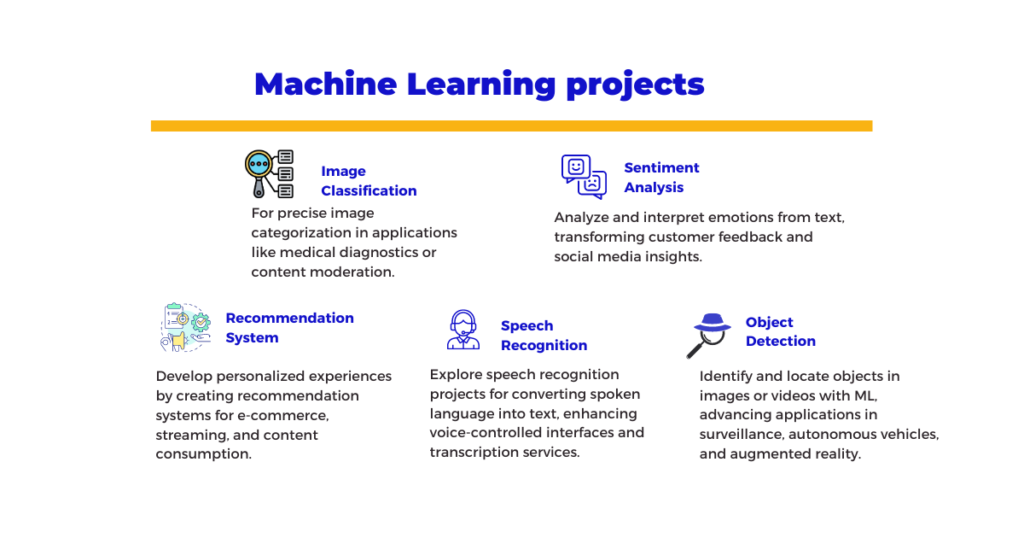What is Machine Learning? And how do I become an ML Engineer? All your questions were answered! Master the ML workflow, libraries, projects, and salary secrets!

Machine learning (ML) is a subfield of artificial intelligence (AI) that focuses on the development of computer algorithms that can learn from data and improve their performance on a specific task over time. Imagine a child learning to identify different types of cars. Initially, they might need you to point out each car and tell them its name. But over time, they start to identify the patterns that distinguish cars from other objects, and eventually, they can do it on their own.
Imagine a computer that not only follows instructions but also learns from them. That’s the magic of machine learning (ML), a field of artificial intelligence (AI) where algorithms evolve with experience, unlocking a world of possibilities.
Before we delve into its intricate workings, let’s crack the code on its core concepts.
Learning on Autopilot: Unlike traditional, rule-based programs, ML algorithms don’t need explicit instructions. Instead, they devour training data, and sets of examples used to identify patterns and build models. Think of these models as brain maps, constantly refining their understanding of the world through the data they consume. This allows them to make predictions, whether it’s classifying an email as spam, recommending the perfect movie for you, or recognizing a loved one’s face in a photo.
A Historical Timeline: Though the term “machine learning” first surfaced in the 1950s, its roots date back centuries. Early pioneers like Ada Lovelace laid the groundwork for theoretical algorithms, while Alan Turing envisioned “learning machines” capable of intelligent behavior. Key breakthroughs throughout the 20th century, like artificial neural networks and statistical learning methods, paved the way for the explosive growth we witness today.
Everyday Encounters with ML: Look around, and you’ll see machine learning fingerprints everywhere. Search engines predict your next query based on past searches, recommendation systems suggest music you might love, and image recognition powers your phone’s face unlock. The list goes on: from speech recognition in voice assistants to spam filters shielding your inbox, ML has become an invisible friend, quietly enhancing our lives.
Embarking on a career as a Machine Learning Engineer is an exciting journey that requires a combination of education, skills development, and practical experience. In this guide, we will outline the essential steps to help you pave the way to becoming a proficient Machine Learning Engineer.
What is a Machine Learning engineer?

A Machine Learning Engineer is a professional at the intersection of software engineering and machine learning, specializing in creating programs that empower computers to learn and adapt autonomously. Much like software engineers, they exhibit proficiency in programming languages and are well-versed in tools such as IDEs, GitHub, and Docker.
Core Responsibilities:
- Programming Proficiency: Machine learning engineers are adept programmers, utilizing their skills to develop software that enables computers to learn from data.
- Integration of Software Engineering and ML: The distinguishing feature of a machine learning engineer is the fusion of software engineering expertise with in-depth knowledge of machine learning principles.
- Focus on Self-Learning Systems: Unlike traditional software engineers, machine learning engineers center their efforts on creating programs that facilitate self-learning in computers.
- Data-to-Product Conversion: The primary objective is to convert data into a tangible product. Machine learning engineers play a crucial role in transforming raw data into predictive models and automated systems.
- Research and Development: Engaged in continuous research, machine learning engineers explore innovative approaches to improve and refine self-learning algorithms.
- Model Building and Design: Machine learning engineers are involved in the entire lifecycle of model development, from conceptualization and design to implementation and optimization.
Key Distinctions:
- Autonomous Learning Emphasis: The primary focus is on developing systems that can autonomously learn and adapt, distinguishing them from conventional software engineering roles.
- Predictive Modeling: Machine learning engineers specialize in creating predictive models, enabling computers to make informed decisions based on patterns and data.
- Automation of Processes: They contribute to the automation of various processes by leveraging machine learning algorithms, leading to increased efficiency and accuracy.
Technical Soundness:
- Research-Driven Approach: Machine learning engineers approach problem-solving with a research-oriented mindset, staying abreast of the latest advancements in both machine learning and software engineering.
- Technical Design and Implementation: Proficient in designing and implementing technically sound solutions, machine learning engineers ensure that the developed systems meet the desired objectives.
In summary, a Machine Learning engineer is a skilled professional who harmoniously blends the principles of software engineering with the intricacies of machine learning, working towards the goal of transforming data into intelligent, self-learning products and systems.
Cracking the Machine Learning Code: Algorithms, Models, and Methods
Explore the intricate world of ML, from cutting-edge algorithms to advanced models. Elevate your understanding with insightful methods. Let the journey to mastering Machine Learning begin!
- Behind the Curtain of Algorithms: But how do these algorithms learn? Imagine a vast network of interconnected nodes, each representing a “neuron” in a digital brain. As data flows through, these nodes adjust their connections, strengthening some and weakening others, until patterns emerge. This iterative process, known as optimization, helps the model refine its understanding of the data.
- Model Mayhem: Just like tools in a toolbox, different ML models serve distinct purposes. Neural networks, mimicking the human brain’s structure, excel at complex tasks like image recognition and language translation. Support vector machines, on the other hand, are champions of classification, drawing clear boundaries between distinct data points. Other models, like Bayesian networks and decision trees, offer unique strengths, each tailor-made for specific problems.
- Learning Paradigms: But how do these models “know” what to learn? This depends on the learning paradigm. Supervised learning is the teacher-student relationship, where labeled data (with both inputs and outputs) guides the model towards making accurate predictions. Think of spam filters trained on labeled emails—each “spam” or “not spam” example teaches the model to identify new emails correctly.
- Unsupervised learning throws away the training wheels. With unlabeled data, the model must discover patterns on its own. Imagine clustering customer data to identify distinct market segments—the model finds hidden groupings without any prior labels. Finally, reinforcement learning takes a trial-and-error approach. Imagine an AI playing a game; its actions receive rewards or penalties, shaping its future decisions through a “learn by doing” process.
- Methodological Toolbox: Now, let’s explore the arsenal of methods these models wield. Classification puts data into pre-defined categories, like sorting emails or identifying objects in images. Regression models relationships between variables, predicting trends like stock prices or housing values. Clustering uncovers hidden patterns and groupings, ideal for market segmentation or anomaly detection. Finally, dimensionality reduction tackles data overload by condensing complex datasets into manageable forms, facilitating better understanding and analysis.
- ML vs. Traditional Software: A Face-Off: So, why choose ML over traditional software? ML’s superpowers lie in its adaptability and flexibility. It thrives on data, constantly improving its predictions over time. However, traditional software still reigns supreme in tasks requiring well-defined rules and deterministic outcomes. The key is understanding where each shines—think of ML as a creative problem solver, while traditional software excels at predictable, rule-based tasks.
- Limitations and Challenges: Of course, ML isn’t perfect. Its dependence on data exposes vulnerabilities like bias and interpretability. Biases in training data can lead to unfair or discriminatory outcomes, highlighting the need for responsible data sourcing and model development. Additionally, understanding how complex models arrive at their conclusions can be challenging, making it difficult to explain their decisions or gain trust in their predictions.
This is just the first step in our journey through the intricate world of machine learning algorithms. In the next section, we’ll dive deeper into the practical aspects of ML development, from data handling to real-world case studies, and explore the exciting future possibilities this field holds.
The Machine Learning Development Workflow
Building an effective machine learning model isn’t simply an act of inspiration; it’s a meticulously crafted journey from data collection to real-world application. Buckle up as we dissect the key stages of this fascinating process:
1. Data, the Indispensable Fuel: Every ML journey starts with data, the raw material fueling the learning process. Collection involves gathering relevant data from various sources, be it internal databases, sensors, web scraping, or external datasets. But data isn’t always pristine. Cleaning becomes crucial in tackling issues like missing values, inconsistencies, and duplicates. Imagine scrubbing a dirty canvas before painting; clean data lays the foundation for a clear and accurate model.
2. Model Training: Where Magic Happens: Now, the cleaned data gets fed to the chosen algorithm. This is where the training phase kicks in. Think of it as the model going to school, learning from the data to identify patterns and relationships. This iterative process, involving optimization techniques, fine-tunes the model’s parameters, gradually sharpening its predictive abilities.
3. Deployment: From Sandbox to Reality: Once trained, the model graduates to the real world. Deployment involves integrating it into the target application, be it a website, mobile app, or even physical machinery. This can involve challenges like scaling the model to handle large volumes of data, ensuring its security and reliability, and monitoring its performance in production.
Real-World Case Studies: ML in Action
Now, let’s witness the power of ML in action, exploring how companies are harnessing its magic:
- Netflix: Recommends movies and shows you’ll love based on your past viewing habits, a testament to the power of collaborative filtering algorithms.
- Spotify: Creates personalized playlists that match your musical taste, using clustering techniques to group similar songs and identify your preferences.
- Fraud Detection: Banks and financial institutions utilize anomaly detection algorithms to identify suspicious transactions and prevent fraud in real time.
- Medical Diagnosis: AI-powered systems are being developed to analyze medical images and assist doctors in diagnosis, potentially leading to earlier and more accurate detection of diseases.
These are just a glimpse into the vast potential of ML. As the field continues to evolve, we can expect even more transformative applications in healthcare, climate change, and beyond.
Remember, the ML development workflow is an iterative process. Data insights can inform model refinement, leading to improved performance and real-world impact. The key lies in fostering a culture of continuous learning and experimentation, which will allow us to unlock the full potential of this revolutionary technology.
How to Become a Machine Learning Engineer?
So, the magic of machine learning has captivated you, and you’re eager to join the ranks of those building these intelligent systems. But where do you start? Don’t worry, aspiring engineer, for the path to becoming an ML whiz is paved with excitement and resources. Let’s unveil the essential steps you can take to turn your passion into a fulfilling career:
Undergraduate Degree
For aspiring machine learning engineers, a bachelor’s degree in mathematics, data science, computer science, or computer programming is ideal. Related fields like statistics or physics can also be applicable. Business degrees can be a starting point, but technical training in essential sciences is necessary for a comprehensive skill set.
Master’s or Ph.D.
While a Master’s degree or Ph.D. is not strictly necessary to become a machine learning engineer, it can significantly enhance your opportunities and skill set. Many machine learning roles may require or prefer advanced degrees, especially for research-focused positions or specialized domains within the field.
Hands-On Experience
Practical experience is invaluable for gaining proficiency in machine learning. Hands-on engagement with algorithms and software design allows you to apply theoretical knowledge to real-world scenarios, fostering a deeper understanding of machine learning concepts.
Advanced Mathematics Knowledge
Machine learning engineers must possess advanced knowledge of mathematics and strong data analytical skills. A solid grasp of mathematical concepts is crucial for developing and fine-tuning Machine Learning algorithms.
Fundamentals of Computer Science
Understanding the basics of computer science is essential for Machine Learning engineers. This includes knowledge of data structures, data modeling, algorithms, software, and computer architecture, forming the backbone of a successful career in machine learning.
Automation Practices
Familiarity with essential automation practices is beneficial for those aspiring to excel in the field of machine learning. This understanding enables you to streamline processes and enhance efficiency in developing Machine Learning solutions.
System Design Concepts
System design concepts are critical for machine learning engineers. Knowing how to architect systems ensures the efficient implementation of machine learning models and solutions within broader technological frameworks.
Additional Skills for Machine Learning Engineers
Data Modeling and Evaluation
Developing expertise in data modeling and evaluation is essential. This skill involves creating effective models and assessing their performance, a crucial aspect of refining machine learning solutions.
Application of Machine Learning Algorithms
Aspiring machine learning engineers should learn how to apply machine learning algorithms to various problems. This can be achieved through hands-on practice using datasets, machine learning libraries, and online learning resources.
By combining these qualifications and skills with a structured learning approach, aspiring machine learning engineers can embark on a successful journey in this dynamic and evolving field.
Remember, becoming an ML engineer is a marathon, not a sprint. Be patient, persistent, and passionate. Celebrate your wins, learn from your mistakes, and, above all, enjoy the journey of unlocking the secrets of machine learning. With dedication and the right toolkit, you too can join the ranks of these AI alchemists, shaping the future with every line of code and every innovative model you build.
How to Become a Machine Learning Engineer Without a Degree?
There are several ways to become a Machine Learning engineer without a degree. Here are some steps you can take:
- Learn to code: Python is a popular language for machine learning. You can start by learning the basics of Python programming language and then move on to more advanced topics.
- Enroll in a machine learning course: There are many online courses available that can teach you the fundamentals of machine learning. Some popular platforms include Coursera, Udemy, and edX.
- Try a personal machine learning project: Once you have a basic understanding of machine learning, try building a project on your own. This will help you gain practical experience and build your portfolio.
- Join online machine learning communities or participate in a contest: Joining online communities such as Kaggle or GitHub can help you connect with other machine learning enthusiasts and learn from their experiences.
- Apply to machine learning internships and jobs: Once you have gained enough knowledge and experience, start applying for machine learning internships or jobs. You can also consider freelancing or working on your own projects.
Remember, becoming a machine learning engineer without a degree is possible but requires hard work, dedication, and a willingness to learn.
Read Also: Artificial Intelligence: Mechanical Minds to Ethical Algorithms
How long does it take to become a machine learning engineer?
The time it takes to become a machine learning engineer can vary depending on your background, experience, and the amount of time you can dedicate to learning. According to Syracuse University, it can take about 18 months to two years to become a machine learning engineer. However, this is just an estimate and the actual time it takes can be shorter or longer depending on your individual circumstances.
To become a machine learning engineer, you need to have a strong foundation in programming and mathematics. You can start by learning the basics of Python programming language and then move on to more advanced topics.
There are many online courses available that can teach you the fundamentals of machine learning, such as Coursera, Udemy, and edX. Once you have a basic understanding of machine learning, try building a project on your own. This will help you gain practical experience and build your portfolio.
Joining online communities such as Kaggle or GitHub can help you connect with other Machine Learning enthusiasts and learn from their experiences. Once you have gained enough knowledge and experience, start applying for machine learning internships or jobs. You can also consider freelancing or working on your own projects.
Remember, becoming a machine learning engineer requires hard work, dedication, and a willingness to learn. Good luck!
What are some Machine Learning libraries I can use?
There are many Machine Learning libraries available that can help you with your projects. Here are some popular ones:

- NumPy: A popular Python library for multi-dimensional array and matrix processing. It’s ideal for machine learning and artificial intelligence (AI) projects, allowing users to manipulate the matrix to easily improve machine learning performance.
2. Scikit-learn: A very popular machine learning library that is built on NumPy and SciPy. It supports most of the classic supervised and unsupervised learning algorithms, and it can also be used for data mining, modeling, and analysis.


3. TensorFlow: An open-source software library for dataflow and differentiable programming across a range of tasks. It is a symbolic math library, and is also used for machine learning applications such as neural networks.
4. Keras: A high-level neural networks API, written in Python and capable of running on top of TensorFlow, CNTK, or Theano. It was developed with a focus on enabling fast experimentation.


5. PyTorch: An open-source machine learning library based on the Torch library. It is primarily developed by Facebook’s AI Research lab. PyTorch provides two high-level features: tensor computation (like NumPy) with strong GPU acceleration and deep neural networks built on a tape-based autodiff system.
You can find more information about these libraries and others on websites like Coursera, Educba, and upGrad. Good luck with your projects! 😊
What are some Machine Learning projects I can work on?

There are many machine learning projects that you can work on. Here are some ideas to get you started:
- Image classification: Build a model that can classify images into different categories. For example, you can build a model that can identify different types of flowers.
- Sentiment analysis: Develop a model that can analyze text and determine the sentiment behind it. For example, you can build a model that can determine whether a movie review is positive or negative.
- Recommendation system: Build a model that can recommend products or services to users based on their preferences. For example, you can build a model that can recommend movies to users based on their viewing history.
- Speech recognition: Develop a model that can recognize speech and convert it into text. For example, you can build a model that can transcribe audio recordings into text.
- Object detection: Build a model that can detect objects in images or videos. For example, you can build a model that can detect cars in traffic footage.
You can find more ideas and projects on websites like GeeksforGeeks, The Clever Programmer, and DataCamp. Good luck with your projects! 😊
How much do Machine Learning engineers earn?
According to various salary aggregate sites, the average salary for a machine learning engineer in the United States ranges from $116,416 to $140,180 depending on experience, industry, and location. The average salary for a machine learning engineer in the United States is $161,555 per year. The salary range for a machine learning engineer is $44K-$170K.
It’s important to note that the salary of a machine learning engineer can be influenced by many factors, such as experience, industry, and geographic location. According to Glassdoor, the experience breaks down as follows:
- 0-1 years: $127,350
- 1-3 years: $144,572
- 4-6 years: $150,193
- 7-9 years: $154,779
- 10-14 years: $162,356
- 15+ years: $170,603
Machine learning engineers are in high demand in many industries, including healthcare, transportation, finance, agriculture, and cybersecurity. If you’re interested in pursuing a career in machine learning engineering, you can expect to make much more than the median salary in the United States.
Conclusion
We’ve embarked on a whirlwind journey through the fascinating world of machine learning, exploring its inner workings, potential applications, and real-world examples. Now, as we stand at the crossroads of the present and future, let’s reflect on the key takeaways and peer into the exciting possibilities that lie ahead.
A Recap of Wonders: Machine learning has unveiled its magic, demonstrating its ability to learn, adapt, and evolve. We’ve witnessed how algorithms decipher patterns in data, generating predictions from spam filtering to image recognition. Different models, like neural networks and support vector machines, tackle diverse tasks, while supervised, unsupervised, and reinforcement learning offer unique learning paradigms.
We’ve also acknowledged the strengths and limitations of ML, its dependence on data, and the challenges of bias and interpretability. Importantly, we’ve delved into the intricate development workflow, from data collection and cleaning to model training and deployment, highlighting the critical role of continuous learning and refinement.
Open Questions Remain: Despite its advancements, several questions remain open for exploration. Can we achieve true artificial general intelligence, replicating the vast learning capabilities of the human brain? How do we mitigate biases and ensure the ethical development of ML systems? Can we make complex models more interpretable, fostering trust and transparency? These are crucial questions that will shape the future trajectory of this field.
Predictions for an ML-Powered Future: As we gaze into the crystal ball, the future seems ablaze with the potential of machine learning. Imagine personalized healthcare with AI-powered diagnosis and treatment plans. Envision self-driving cars that navigate city streets with superhuman precision. Picture an education system tailored to individual learning styles, maximizing the potential of every student. These are just a few glimpses of the transformative world that awaits, where ML acts as a silent co-pilot, enhancing every aspect of our lives.
The journey of machine learning has just begun. As we continue to delve deeper into its intricacies, harness its potential responsibly, and address its challenges, we stand poised to unlock a future brimming with possibilities. This is not just a technological revolution; it’s a chance to reshape our world for the better, one algorithm at a time.
What exactly is machine learning?
Machine learning is a subfield of artificial intelligence (AI) that focuses on the development of algorithms and statistical models that enable computer systems to improve their performance on a specific task through experience and learning from data, without being explicitly programmed. In other words, machine learning allows computers to learn patterns and make predictions or decisions based on data inputs.
What are the real-world applications of machine learning?
From recommending your next favorite movie to detecting fraudulent transactions, ML powers diverse applications across various industries. It helps doctors diagnose diseases more accurately, personalizes your online experience, and even fuels self-driving cars!
What skills do I need to become a machine learning engineer?
Strong mathematical and coding skills are essential, especially in areas like statistics, linear algebra, and programming languages like Python or R. Additionally, understanding data structures, algorithms, and software engineering principles is crucial. Bonus points for a grasp of business acumen to understand the practical needs of different applications.
Do I need a degree to become an ML engineer?
While a degree in computer science, data science, or mathematics can provide a strong foundation, it’s not a mandatory requirement. The field welcomes self-driven learners who acquire relevant skills through online courses, bootcamps, and hands-on projects. Dedication, passion for learning, and a knack for problem-solving are key ingredients for success.
Where do I start my journey to becoming an ML engineer?
Start by building your knowledge base through online courses, books, and tutorials. Focus on core concepts like training data, algorithms, and different types of learning. Next, get your hands dirty with personal projects, participating in online communities like Kaggle, and taking on freelance gigs. Finally, stay relevant by continuously learning new tools and keeping up with the ever-evolving landscape of ML.



[…] Machines learn from data, adapt, and improve. Whether it’s quality control or demand forecasting, machine learning optimizes […]
Das Tipico Casino ist eine beliebte Anlaufstelle für alle Casino-Fans, die gerne ihr Glück versuchen wollen. Besonders das Roulette-Spiel erfreut sich großer Beliebtheit, da es sowohl einfach zu verstehen als auch spannend ist. Ein wichtiger Aspekt beim Roulette-Spiel ist der Mindesteinsatz, da dieser die Höhe des Risikos und potenzieller Gewinne bestimmt.
Im Tipico Casino beträgt der Mindesteinsatz am Roulette-Tisch in der Regel 1 Euro. Das bedeutet, dass Spieler bereits mit einem vergleichsweise kleinen Betrag am Spiel teilnehmen können. Dadurch wird das Spielen auch für Einsteiger attraktiv, die nicht gleich hohe Summen setzen möchten.
Der Mindesteinsatz beim Roulette kann je nach Tischvariante variieren, daher ist es wichtig, sich vor dem Spiel Гјber die genauen Regeln zu informieren. In jedem Fall ist es ratsam, verantwortungsvoll mit dem eigenen Budget umzugehen und nur so viel zu setzen, wie man sich leisten kann zu verlieren.
Durch den niedrigen Mindesteinsatz beim Roulette im Tipico Casino wird das Spiel für eine breite Zielgruppe zugänglich gemacht und sorgt für ein unterhaltsames Spielerlebnis. Also nichts wie ran an den Tisch und viel Spaß beim Setzen und Gewinnen!
https://tipicocasino.one/
Remarkable issues here. I am very glad to look your post.
Thank you a lot and I’m taking a look forward to contact you.
Will you kindly drop me a e-mail?
Feel free to visit my website :: vpn special code